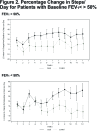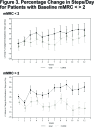A Patient-Centered Walking Program for COPD
- PMID: 28848902
- PMCID: PMC5556960
- DOI: 10.15326/jcopdf.3.4.2016.0142
A Patient-Centered Walking Program for COPD
Abstract
Background: Pulmonary rehabilitation programs improve dyspnea and health status associated with chronic obstructive pulmonary disease (COPD), but benefits wane when patients return to a sedentary lifestyle. This study tested a simple, low-resource, low-cost home walking program. Methods: In this single center, 3-month study, 115 COPD patients were randomized to a control cohort or a goal setting cohort. Each patient met with study staff and received 5 telephone calls at 2-week intervals. During these contacts, the Goal group was assisted by a wellness coach who helped them set personal activity goals. All patients wore a pedometer to record daily steps, the primary study outcome. Results: Over the 12-week interval, the average step-per-days was 36% higher for the Goal cohort patients (Week 12 mean = 4390) than for Control patients (mean = 3790). No group differences emerged on the modified Medical Research Council (mMRC) dyspnea scale, the COPD Assessment Test, or the St. George's Respiratory Questionnaire. Secondary analyses indicated that even patients with greater disease severity, including those with an mMRC score >2 or forced expiratory volume in 1 second (FEV1) % predicted below 50%, increased their walking relative to Control patients. Almost half (48%) of Goal patients successfully reached at least one personal goal such as increasing stamina and activity, or decreasing shortness of breath or weight. Conclusions: A relatively low-resource wellness coaching, goal-setting intervention resulted in a small improvement in the activity level of COPD patients over a 12-week period including those with marked pulmonary impairment. Further investigation should be directed at understanding the optimal blend of in person and remote coaching needed to produce the greatest cost-to-benefit ratio.
Keywords: chronic obstructive pulomonary disease; copd; patient-centered; pulmonary rehabilitation; walking.
Conflict of interest statement
DS is an employee of GlaxoSmithKline and holds stock/shares in GlaxoSmithKline. AE, now an employee of PAREXEL International, was an employee of GlaxoSmithKline at the time the study was conducted and holds stock/shares in GlaxoSmithKline. SS was an employee of GlaxoSmithKline at the time the study was conducted and holds stock /shares in GlaxoSmithKline. All other authors have confirmed that they have no conflict of interest related to this manuscript.
References
-
- Alahmari A,Patel A,Kowlessar B,et al. Daily activity during stability and exacerbation of chronic obstructive pulmonary disease. BMC Pulm Med. 2014;14:98. doi: http://dx.doi.org/10.1186/1471-2466-14-98 - PMC - PubMed
-
- Gouzi F,Prefaut C,Abdellaoui A,et al. Evidence of an early physical activity reduction in chronic obstructive pulmonary disease patients. Arch Phys Med Rehabil. 2011;92(10):1611-1617. doi: http://dx.doi.org/10.1016/j.apmr.2011.05.012 - PubMed
-
- Garcia-Aymerich J,Lange P,Benet M,Schnohr P,Anto J. Regular physical activity reduces hospital admission and mortality in chronic obstructive pulmonary disease: a population based cohort study. Thorax. 2006;61(9):772-778. doi: http://dx.doi.org/10.1136/thx.2006.060145 - PMC - PubMed
-
- Waschki B,Kirsten A,Holz O,et al. Physical activity is the strongest predictor of all-cause mortality in patients with COPD: a prospective cohort study. Chest. 2011;140(2):331-342. doi: http://dx.doi.org/10.1378/chest.10-2521 - PubMed
-
- Farias C,Resqueti V,Dias F,Borghi-Silva A,Arena R,Fregonezi G. Costs and benefits of pulmonary rehabilitation in chronic obstructive pulmonary disease: a randomized controlled trial. Braz J Phys Ther. 2014;18(2):165-173. doi: http://dx.doi.org/10.1590/S1413-35552012005000151 - PMC - PubMed
LinkOut - more resources
Full Text Sources
Other Literature Sources
Miscellaneous



